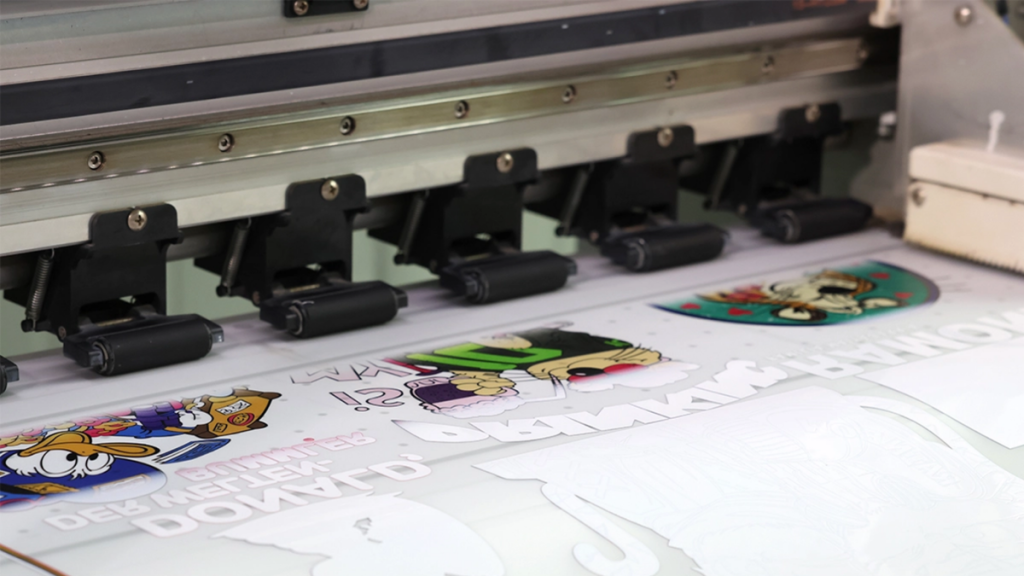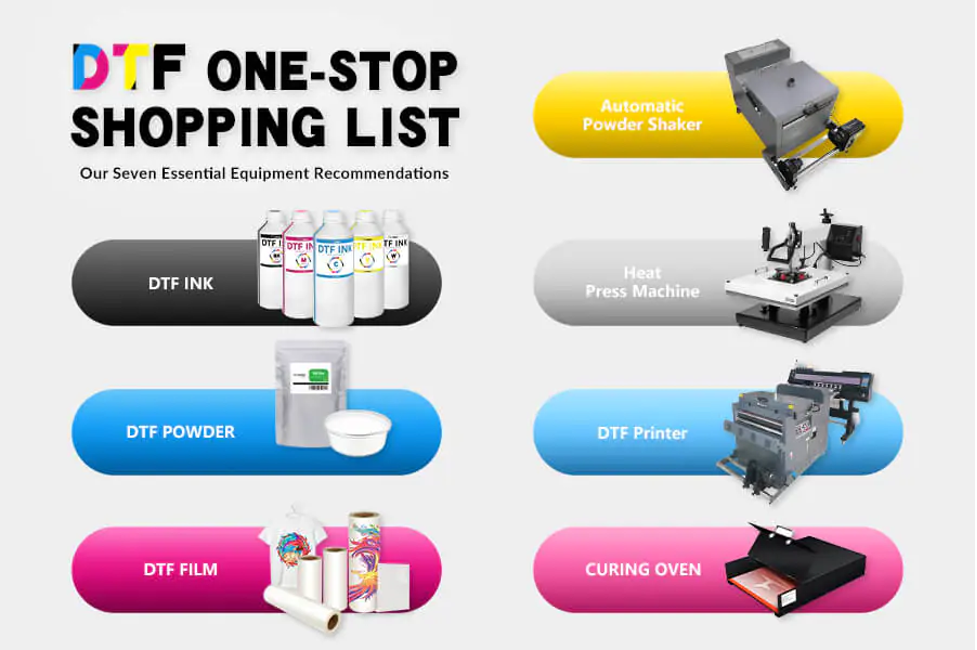Direct-to-film, known as DTF transfer printing, is a cutting-edge technology that is causing a stir in small-business and home-based creators, revolutionizing the custom printing industry.
Whether you’re a do-it-yourselfer or an innovative business owner, understanding how to make DTF transfers at home or having a DTF printer for small business can contribute to countless opportunities for personalized clothing and accessories.
In this article, we will guide you through how to make DTF transfers at home and highlight the basics as well as the best DTF ink and printer for home use, providing tips and techniques to achieve professional-quality DTF results.
What Is DTF Transfer Printing?
If you’ve been wondering how to make DTF transfers at home, let’s begin by covering the basics. DTF printing involves employing specialized inks to print designs onto a unique polyethylene terephthalate film, which is then heated and compressed to transfer the images onto the finished product.
In addition to DTF printing, DTG printing is also a popular method for transferring designs onto fabric. When comparing DTF vs DTG printing, the main difference lies between DTG and DTF in how they are applied. DTG prints directly onto the fabric, while DTF uses transfer films, offering greater flexibility for transferring designs onto a variety of materials. This makes DTF more versatile for a wide range of applications.
Additionally, DTF transfers are also more successful on natural and synthetic materials, light and dark fabrics, and even non-textile surfaces, outperforming screen printing or sublimation in these areas.
Beyond versatility, DTF printing is more affordable and accessible compared to industrial printing methods. Unlike traditional techniques that often require costly equipment and setup, DTF offers a cost-effective solution that is easier to implement, making it an ideal choice for small businesses and hobbyists alike.
Given these advantages, more owners and entrepreneurs are seizing the opportunity to explore DTF printing for their businesses, sparking curiosity about how to make DTF transfers at home with a DTF printer.
Equipment and Materials Needed for DTF Printing at Home
Learning how to make DTF transfers at home is simple, but you will require specialized equipment. The best DTF printer for beginners should be dependable and user-friendly. Consider investing in a dedicated and high-quality DTF printer for home use rather than attempting to convert standard printers, as specialized equipment ensures better results at the end.
The basic setup for DTF printing should include:
- Design software (e.g., Photoshop, CorelDRAW): create or modify your artwork before printing
- A DTF printer: print your design onto transfer films
- High-quality DTF ink: the key to achieving vibrant, high-quality prints
- Transfer films: transfer the printed design onto the fabric
- Heat press machine: apply the design onto the fabric by using heat and pressure, ensuring a durable bond
- Powder curing oven (optional for better results): cure the adhesive powder for improved adhesion and longevity of the print
- Hot-melt adhesive powder: coat the printed design on the transfer film, allowing it to stick to the fabric during the heat pressing process.
How to make DTF transfers at home becomes quite simple when you invest in a complete DTF starter kit, which includes all of the necessary equipment and materials needed to start printing. When picking supplies, it’s also important to consider quality over cost, as higher-quality materials have a direct impact on your ultimate results.
Step-by-Step Guide: How to Do DTF Transfers at Home
How to make DTF transfers at home involves an easy process when you follow these step-by-step instructions, guiding you from preparing your design to applying the transfer to your fabric.
Set Up Your Printer and Design
Use design software (such as Photoshop or CorelDRAW) to create the design you want to transfer. Make sure the design size and resolution are appropriate for your target fabric. Then, transfer the design to a DTF printer and print using DTF inks (cyan, magenta, yellow, black, white).
Apply the Powder Adhesive
After printing, the design on the transfer film is coated with a thin, even layer of powder adhesive. This powder helps secure the ink on the film, ensuring the transfer’s quality and long-lasting durability.
Cure the Powder and Ink
The powder-coated transfer film is then placed in a curing oven to heat and fully set the powder and ink, making sure everything is properly prepared for the transfer process. While the curing oven is optional, using it can significantly improve the final result, especially if you’re aiming for higher quality.
Transfer the Design onto the Fabric
Position the cured transfer on your fabric and use a heat press to transfer the cured design onto the fabric. Ensure the temperature is set to around 160°C (320°F) and apply firm pressure for 10-15 seconds. Once done, carefully peel off the transfer film, and your design will be successfully transferred onto the fabric.
Winnerjet: Reliable Brand for DTF Printing
When thinking about how to print DTF transfers at home, Winnerjet provides dependable DTF printing solutions, including the sophisticated DTF printer for small businesses— Winnerjet A2 60CM DTF Printer with i3200 Printhead. Featuring multiple print heads, advanced paper-feeding systems, automatic powder shaker, and user-friendly interface, this DTF printer delivers high quality and stable performance, suitable for long-term DTF business for both beginners and experienced professionals.
Beyond high-performance printers, DTF starter kits from Winnerjet also include the best DTF ink, films, hot melt powder, and ovens, guaranteeing high-quality, long-lasting, and consistent transfers for a wide range of materials.
If you’re looking at how to make DTF transfers at home, Winnerjet may be the right solution for you. They are a trusted brand that offers reliable and high-quality DTF printing solutions, as well as easy and quick DIY starter kits. Explore Winnerjet today and start your DTF printing business!
FAQS
Can I use a regular printer for DTF printing?
No, DTF printing requires specialized printers with specific printheads and ink systems designed to accurately transfer the design onto the film.
How long do DTF transfers last?
DTF transfers are highly durable. With the correct process and proper post-care (such as heat pressing correctly and avoiding excessive washing), the transfer pattern can last for many years without fading or peeling.
What fabrics work best with DTF transfers?
DTF transfers are effective on most materials, including cotton, polyester, mixes, and even leather. They provide clear, long-lasting results on both light and dark-colored fabrics. Even some non-woven materials can be used with DTF transfers.
Do you need special ink for DTF printing?
Yes, DTF printing requires specialized DTF inks. Common DTF inks include CMYK color plus white ink (for enhanced transfer), which is different from the ink used in traditional printers and ensures better adhesion and display of patterns on different materials.
Is DTF printing good quality? Is DTF better than screen printing?
DTF prints are of very high quality and show rich details for complex patterns and a wide range of colors. Compared to screen printing, DTF has better details, gradation effects, and color representation, which makes it particularly suitable for small-scale production.


